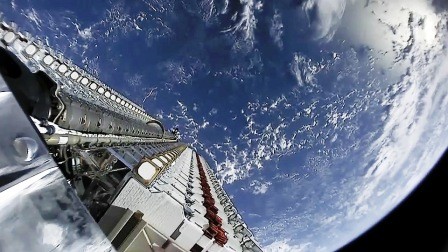The night sky just got busier, and Starlink satellites are leading the charge. On May 20, 2025, SpaceX launched 23 of these sleek, internet-beaming spacecraft into low Earth orbit, marking their 60th Falcon 9 mission of the year. This isn’t just a routine launch—it’s a bold step in SpaceX’s mission to blanket the globe with high-speed internet, even in the most remote corners. From rural farms to ships at sea, Starlink satellites are rewriting how we connect, and their impact is only growing. Let’s dive into the latest developments that make this constellation a game-changer, exploring why these satellites are sparking both awe and debate.
Starlink Satellites Soar to New Heights
The recent May 20 launch from Florida wasn’t just another blip on the radar. A brand-new Falcon 9 rocket carried those 23 Starlink satellites to low Earth orbit, deploying them flawlessly 65 minutes after liftoff. This mission, the 43rd Starlink-specific launch of 2025, underscores SpaceX’s relentless pace. With over 7,500 operational satellites already in orbit, the constellation is the largest of its kind, delivering internet to over 5 million users across 125 countries. Imagine a fisherman in the Pacific or a researcher in Antarctica streaming videos or making calls—this is the power of Starlink’s ever-growing network.
What’s new this time? Some of these satellites boast Direct to Cell capabilities, meaning they can connect directly to your phone without a traditional tower. Texting from a mountain peak? That’s now a reality, with plans for streaming and calls rolling out by 2026. This leap forward has telecom giants on edge, as Starlink satellites redefine what connectivity means.
Global Reach of Starlink Satellites Expands
The global appetite for Starlink’s service is insatiable. Just this month, Saudi Arabia greenlit Starlink for aviation and maritime use, a move announced during a high-profile summit in Riyadh. This opens up new frontiers for pilots and sailors needing reliable internet mid-flight or mid-ocean. Meanwhile, Somalia joined the Starlink club on April 13, 2025, after two years of negotiations, granting SpaceX a license to operate. From Africa to Asia, countries like Vietnam are also testing Starlink on a trial basis, signaling a push to bridge digital divides.
But it’s not all smooth sailing. In South Africa, Starlink faces hurdles over local black empowerment laws, sparking a heated debate. Elon Musk himself called out the restrictions, claiming they block foreign operators like Starlink. This clash highlights the delicate balance between global tech ambitions and local regulations, a tension that’s only growing as Starlink satellites expand their reach.
Challenges and Controversies
| Issue | Impact |
|---|---|
| Light Pollution | Starlink satellites create streaks in telescope images, frustrating astronomers. |
| Orbital Congestion | Over 7,500 satellites raise collision risks, worrying space experts. |
| Geopolitical Tensions | Russia and China target Starlink for disruption, citing military concerns. |
The brilliance of Starlink satellites comes with shadows. Astronomers are up in arms, as these satellites leave glowing trails across night skies, ruining stargazing and research. One amateur astronomer in 2022 described their telescope images as “streaked” disasters, a sentiment echoed by professionals. Then there’s the risk of orbital pile-ups. With thousands of satellites zipping around, experts warn of potential collisions, especially as competitors like Amazon’s Project Kuiper launch their own fleets.
Geopolitically, Starlink is a lightning rod. In Ukraine, it’s a lifeline for troops and civilians, but outages in 2024 raised fears of Russian interference using advanced systems like Tobol and Kalinka. China’s even floated ideas of laser-equipped submarines targeting Starlink satellites. These threats highlight the constellation’s role not just as a commercial venture but as a strategic asset, making it a focal point in global power plays.
The Future of Connectivity
What’s next for Starlink satellites? SpaceX shows no signs of slowing down, with plans to launch hundreds more this year alone. Brazil recently approved 7,500 additional satellites for local operation, doubling SpaceX’s capacity there. Meanwhile, trials like ScotRail’s use of Starlink for train Wi-Fi in Scotland hint at innovative applications. The constellation’s low-orbit design—hundreds of miles closer than traditional satellites—means faster speeds and lower latency, a boon for gamers, remote workers, and emergency services alike.
Yet, the debate rages on. Can Starlink balance its cosmic ambitions with earthly concerns like light pollution and orbital safety? Will it outpace rivals like Amazon’s Kuiper, which just launched its first 27 satellites? One thing’s clear: Starlink satellites are more than just tech—they’re a bold vision of a connected world, sparking wonder and controversy in equal measure. As they light up skies and screens, their story is far from over, and the world is watching, captivated.
Want to see Starlink satellites in action? Check out FindStarlink.com or download the Starlink Tracker app to catch their next flyover in your area. Share your sightings or thoughts on this cosmic revolution in the comments below—let’s keep the conversation orbiting!
